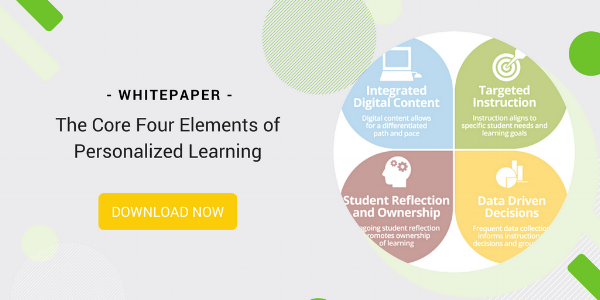
By: Heidi Zollman on October 10th, 2017
How to Personalize Professional Development: One District’s Story
Personalized Learning | School Districts | Innovative Leadership
Close your eyes and imagine yourself in an all-purpose room with uncomfortable chairs and a trainer lecturing to a whole-group about the latest small-group teaching strategies. We’ve all been there, right? Stuck in PD sessions with facilitators who don’t practice what they preach.
What if there were another way? Rochester School Department, an 11-school district serving 4,400 students in New Hampshire, thinks there is. We sat down with Heidi Zollman, Curriculum Administrator, to hear insights on her recent experience designing professional learning.
Question: What inspired you to design more personalized professional development experiences?
Last spring, I attended an Education Elements training. It was a stressful time of year, and my brain was full of to-do lists. I’d hoped to multitask while learning about personalized learning for our district. As I walked in the room, that plan went out the window. Immediately, the session felt different. We know what engagement does for the learning brain, and I experienced it firsthand. We had flex time to make choices based on what we needed, and the support of our colleagues to discuss next steps in our district. I even found myself exploring resources when I was at home. As I reflected on this experience, it became clear that I wanted to try this model during my next training.
I was preparing to present at a four-day competency-based education (CBE) camp of multiple learning groups called “cabins.” I would be working over the course of the four days, with one cabin of teachers, administrators, and support staff as they wrote unit plans. My cabin’s focus was Pathways to Learning, which included evidence-based learning strategies in a CBE model. I asked myself, “how I can meet the wide range of needs of such a diverse audience with varying levels of CBE knowledge and experience?” I knew personalized learning was the answer.
Question: What were your initial steps as you planned your first personalized Professional Development workshop?
I started with identifying what I wanted to do differently: shift to a more reactive presentation mode, provide ample opportunities for participant feedback, and have fun. Instead of creating a lengthy slide presentation and a rigid agenda, I focused on two questions: How could I keep a pulse on participant needs? How could I target my delivery to meet those needs? I used a pre-survey to uncover what participants knew and wanted to know about CBE and created a structured plan for the first day. I created a draft agenda and a flexible slide deck with different sections that could be presented in any order. I planned to use participant input to inform how we spent the remaining three days. I also built multiple modes of participant reflection and feedback including printed templates with sentence starters, electronic daily reflection forms, and post-it protocols. Last, but not least, I looked for opportunities to infuse brain breaks and fun to keep participant energy and engagement high.
Question: How did your first personalized PD workshop go?
I modeled Education Elements’ Core Four throughout the week.
- Student Reflection & Ownership: Each day we began by setting a personal intention and closed by completing an electronic exit ticket. I spent 15 minutes reviewing the exit ticket feedback and created a sketch agenda for the following day. Once we were back together as a group, I asked if the agenda met the cabin’s needs. We adjusted accordingly, adding in collaboration time or removing elements that weren’t needed. Participants really liked their active role in agenda creation.
- Targeted Instruction: Because I had a bank of activities and resources instead of a sequential script, it was very easy to pivot and deliver the content that was most meaningful to my cabin. There were some elements that I did not anticipate being hot topics, such as flexible seating, reflection protocols, and choice of assessment type. I enjoyed having the freedom to dive deeply into these conversations and provide space for in-the-moment dialogue and brainstorming. This paid off as participants included these topics in their unit plans.
- Data-Driven Decisions: Because I used the initial CBE survey results to create the workshop materials, I spent my preparation time so much more wisely. I didn’t waste time creating materials we wouldn’t use. We also used data to guide our fun during the workshop by offering three recess options. Participants could pick from a stroll with leaders, mindfulness yoga, or frisbee based on what would recharge them.
- Integrated Digital Content: Our agenda was a Google Doc, and this small shift was powerful. Participants could interact with it, and even update it as needed.
My reflection: I wasn’t thinking about my slides during this workshop; I was thinking about my learners. In the past, I’ve been so focused on getting through the content that I might not have caught a teacher who wasn’t engaged. In this session, I knew my participants. I had time to connect, to ask questions, to understand what they needed, and to engage in meaningful conversations. Everyone got what they needed, and the unit plans produced prove it. This presentation model was less stressful and made me a more effective facilitator.
Question: Where might you go next with personalized PD in Rochester?
Our next goal is to personalize a district-wide PD day this winter. We’ll host three rounds of 90-minute workshops. In each round, there will be 10 (or more) choice workshops. This is a shift for our district in three ways:
- Teacher Role: Teacher-input determined the choice workshops offered. Teachers will select workshops based on their needs and interests rather than attending mandated sessions based on grade-level or content area.
- Application Time: Each workshop will include 30 minutes of application & collaboration time. In the past, we’ve delivered new content to teachers for the entire PD session. We heard from teachers that they struggle to find time to apply or extend what they’ve learned, so we want to provide the time and space for teachers to modify an upcoming lesson plan or brainstorm a new classroom routine.
- Local Expertise: We’ve asked our own teachers and coaches to present rather than bringing in outside trainers. The expertise within our district often goes untapped. We want to highlight on our local best practices and build our capacity to support great instruction.
After the three rounds of choice workshops, we’ll conclude in a whole-group setting. We plan to explicitly highlight how this day brought specific elements of personalized learning to life, so it is tangible (and hopefully replicable) by our teachers. Each choice workshop will conclude with a short exit ticket gathering teacher reflections and session feedback from participants. The district team is excited to review this data, so we can continue to personalize future professional development. I don’t think we’ll ever go back to a one size fits all professional learning experience.
About Heidi Zollman
Facilitator of teacher professional development as Curriculum Administrator at the Rochester School Department in Rochester, NH. I also consult with other districts and facilitate learning sessions in literacy and Competency-Based Learning. My sessions have been engaging and meaningful learning experiences. I am a lifelong learner, and am always seeking feedback on how to improve learning outcomes for everyone I work with. Follow me on Twitter: @zollmanh.


